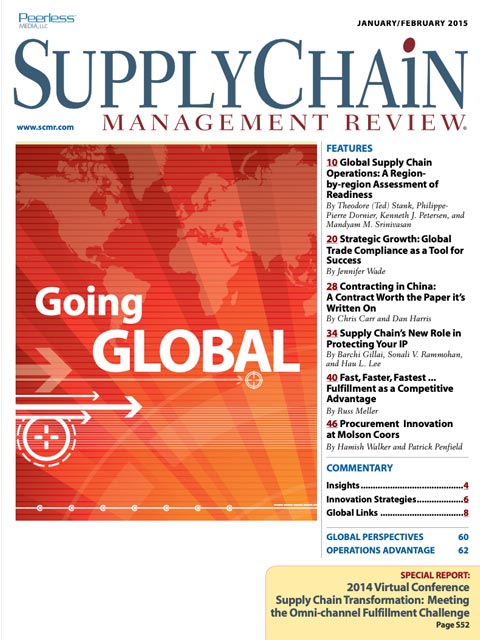Sorry, but your login has failed. Please recheck your login information and resubmit. If your subscription has expired, renew here.
January-February 2015
As long as there have been boats and beasts of burden, intrepid business professionals, governments, and marauders have sought fame, fortune, wealth, and value by going global. Think the Phoenicians, Marco Polo, and the Vikings in days of old. Or in contemporary times, think of China, BRIC, EMEA, and other emerging markets. One could argue that outsourcing to China a few decades ago gave birth to supply chain management as we think of it today. This month we’re including an online bonus column from APQC. While this issue focuses on global management, we didn’t want to miss out on the column. Browse this issue archive.Need Help? Contact customer service 847-559-7581 More options
Many organizations recognize that procurement can provide the business with much more than simply getting the lowest cost for purchased materials and services. They see tremendous potential when the procurement function is aligned with the strategies and goals of other business units as well as the enterprise as a whole. This can take the form of involving other business groups in the selection and appraisal of suppliers, as well as selecting suppliers that can best meet the strategic needs of the organization. The question is whether organizations are taking steps to realize that potential.
According to APQC’s Open Standards Benchmarking in procurement, organizations involve a variety of groups in the selection and appraisal of suppliers, from marketing and sales to the logistics function, depending on the needs of the organization. However, APQC’s data also shows that organizations most often involve the R&D/engineering group and manufacturing group in this process. About 60 percent of organizations involve the R&D group in supplier selection and appraisal, and just over 56 percent of organizations involve the manufacturing group.
These results indicate that organizations are aiming to use procurement to meet the broader needs of the organization. By including functions involved in the design and manufacturing of their products, organizations can make sure that the materials purchased by the procurement function provide the best value with respect to cost, design, functionality, and suitability for their manufacturing processes.
 |
This complete article is available to subscribers
only. Click on Log In Now at the top of this article for full access. Or, Start your PLUS+ subscription for instant access. |
SC
MR
Sorry, but your login has failed. Please recheck your login information and resubmit. If your subscription has expired, renew here.
January-February 2015
As long as there have been boats and beasts of burden, intrepid business professionals, governments, and marauders have sought fame, fortune, wealth, and value by going global. Think the Phoenicians, Marco Polo, and… Browse this issue archive. Access your online digital edition. Download a PDF file of the January-February 2015 issue.
 |
Download Article PDF |
Many organizations recognize that procurement can provide the business with much more than simply getting the lowest cost for purchased materials and services. They see tremendous potential when the procurement function is aligned with the strategies and goals of other business units as well as the enterprise as a whole. This can take the form of involving other business groups in the selection and appraisal of suppliers, as well as selecting suppliers that can best meet the strategic needs of the organization. The question is whether organizations are taking steps to realize that potential.
According to APQC’s Open Standards Benchmarking in procurement, organizations involve a variety of groups in the selection and appraisal of suppliers, from marketing and sales to the logistics function, depending on the needs of the organization. However, APQC’s data also shows that organizations most often involve the R&D/engineering group and manufacturing group in this process. About 60 percent of organizations involve the R&D group in supplier selection and appraisal, and just over 56 percent of organizations involve the manufacturing group.
These results indicate that organizations are aiming to use procurement to meet the broader needs of the organization. By including functions involved in the design and manufacturing of their products, organizations can make sure that the materials purchased by the procurement function provide the best value with respect to cost, design, functionality, and suitability for their manufacturing processes.
 |
SUBSCRIBERS: Click here to download PDF of the full article. |
SC
MR

Latest Supply Chain News
Latest Podcast

 Explore
Explore
Latest Supply Chain News
- AdventHealth named top healthcare supply chain by Gartner
- Geopolitical readiness in supply chains: Strategic challenges for leaders
- Unlocking retention: The role employee engagement plays
- Can supply chain managers embrace an entrepreneurial mindset?
- Challenges to ESG reporting
- With capacity to spare, logistics real estate demand remains subdued
- More latest news
Latest Resources

Subscribe

Supply Chain Management Review delivers the best industry content.

Editors’ Picks





